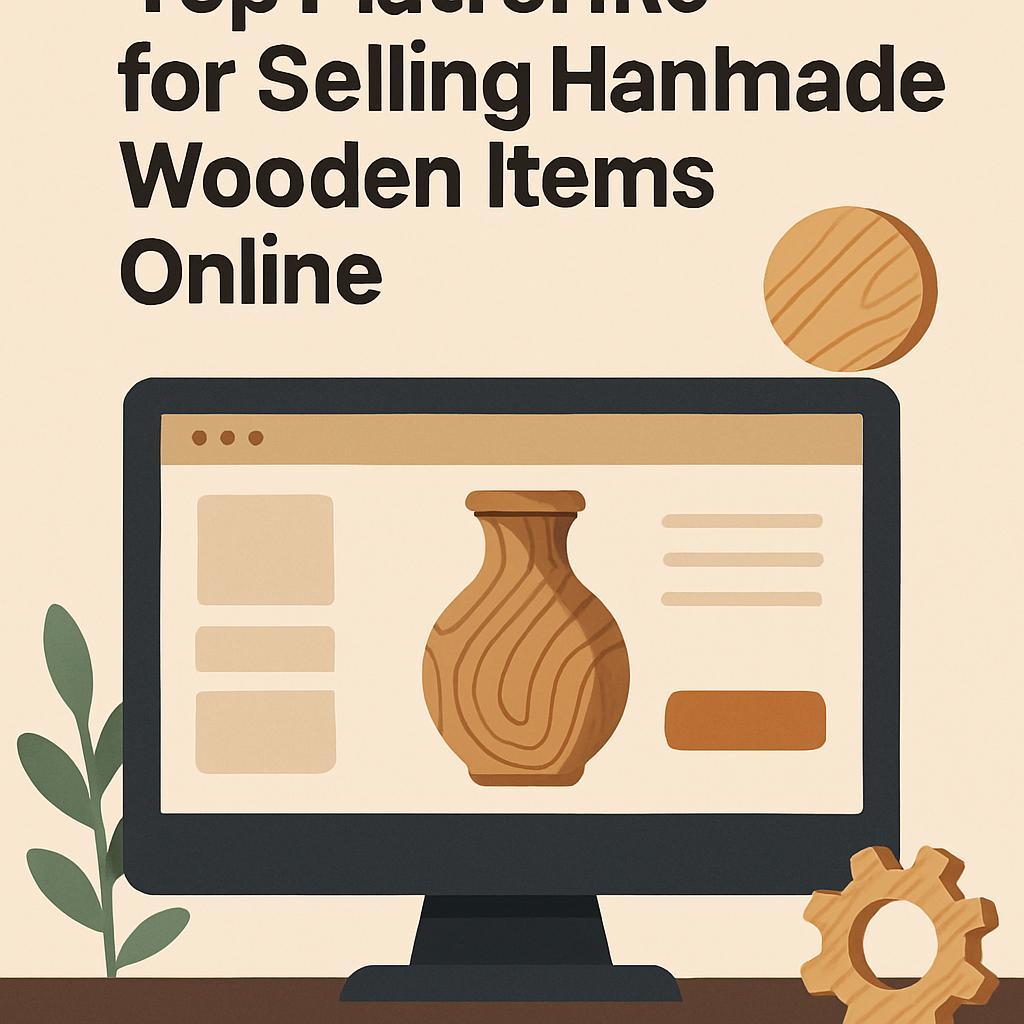
A single click can turn a hand-made walnut bowl into a worldwide story. For woodworking enthusiasts, choosing the right online home matters: it shapes who discovers your work, how much you earn, and how easily you can grow your craft into a business. This article breaks down the top platforms, weighing visibility, fees, and audience vibe. You'll learn how each site handles listings, shipping, and customer trust-plus practical tips for photography, pricing, and branding. By the end, you'll know which platform fits your style, scale, and sales goals.
Selecting the Best Platforms for Selling Handmade Wooden Items Online
Choosing the right platform starts with who you are selling to and how you want to present your wooden items. Handmade wooden pieces often appeal to shoppers who value craft, material stories, and enduring shipping. Consider whether you want a ready-made storefront with built-in revelation or a flexible space you control entirely. The question isn't only where to list items, but how your brand, photography, and pricing strategy will translate across channels.
Marketplaces like Etsy pull in woodworkers with a built-in audience searching for unique, handmade goods. They offer trust signals, robust search, and straightforward checkout, but fees and listing limits matter.A self-hosted store with Shopify or WooCommerce gives you complete branding control, custom shipping rules, and inventory management-but it takes time and a solid marketing plan to attract visitors. Social channels such as Instagram Shopping and Facebook Marketplace can drive discovery directly to a product page, especially with high-quality imagery and storytelling about your woodwork.
Hear is a rapid compare-and-contrast to guide your selection:
| Platform | Fees model | Best for | Key considerations |
|---|---|---|---|
| Etsy | Listing fees + transaction + processing | Handmade, small-batch items | Audience; fees can add up; competitive |
| Shopify/WooCommerce | Platform + payment processing; hosting if applicable | Full branding control | Requires marketing & traffic generation |
| Instagram Shopping | Depends on linked storefront; checkout options | Visual discovery; social selling | Needs strong content & audience |
| Amazon Handmade | Fees vary; invitation-based | Trusted marketplace; broad reach | Submission process; less customization |
Whichever route you choose, you can maximize results by aligning each listing with your brand, presenting clear feature benefits of your wood pieces, and offering consistent shipping options. Optimize photography with close-ups of grain, finish, and joinery; write scannable descriptions that answer common questions about wood type, care, and lead time; and test pricing tiers or promotions to find sweet spots. If you run more than one channel, use cross-listing for evergreen items and reserve seasonal pieces for platform-specific campaigns, and monitor metrics to learn which platform truly earns the best return.
Build Your Dream Workshop on a Budget →
Crafting Listings that Highlight woodwork Details and Materials
Lead with the wood itself. In your listing, begin with a concise, evocative snapshot of the piece's character: the species, where the wood came from, and how the grain runs with its natural figure. Use specimen-level details like thickness, dimensions, and weight to help buyers picture scale.Emphasize how the material informs durability and feel, and pair each detail with a practical benefit (for example, “solid maple for stable, smooth surfaces” or “reclaimed oak with rich age lines that tell a story”). This approach invites wood enthusiasts to see the craft behind the product and to trust the material as a foundation of quality.
Next, translate those details into your product narrative through precise, scannable copy and clean photography. Describe the finishes and the joinery the piece features, such as hand-cut dovetails or mortise-and-tenon connections, then explain how the finish protects and enhances the wood without obscuring its character. Pair close-up photos of grain, edge chamfers, and tool marks with a hero shot that shows the item in context. Include measurements in both inches and centimeters, and note seasonal care steps to help buyers plan long-term maintenance.
| Wood Type | Oak, Walnut, Maple (local options) |
| Finish | Oil, wax, or low-sheen varnish |
| Hardware | Brass hinges, soft-close components |
| Special Features | Hand-cut joinery, custom sizing |
translate the table into concrete listing sections: a dedicated Materials and care line, a short “Why this piece matters” narrative, and a simple care guide.Keep your tone neutral and informative, but let your passion for woodwork shine through. Invite questions and provide clear policies on shipping and customization to reduce back-and-forth.By spotlighting material quality and craftsmanship, you create listings that resonate with buyers who value tangible, lasting wood items.
Build Your Dream Workshop on a Budget →
Pricing and Fees Tactics for Handmade wooden Items on marketplaces
pricing on marketplaces isn't just about the sticker price. It's about mapping the true cost of every handmade wooden piece-materials, time, finishing, packaging, and the platform's fees-and building a margin that survives the net revenue after charges. Start with a cost sheet for each item showing direct costs and allocated overhead, then add a built-in buffer for returns, shrinkage, and exchange rates. When you price, consider whether the platform charges listing fees, transaction fees, payment processing, and promotion/ads costs. If a piece takes longer to craft or requires premium wood,reflect that in a higher price; for smaller items,a lower price with efficient packaging can win volume. Always keep a record of fee estimates per platform to compare apples to apples.
Smart tactics to optimize margins include separating shipping costs from the item price when the platform allows, and using free-ship thresholds only when your margin can sustain it. such as,price the core item with a clear,psychological price (ending in .99 or .95) and offer flat-rate or calculated shipping as a separate line item, ensuring the customer sees value but that margins stay intact after fees. Consider listing in fewer, higher-margin categories or using bundles (two small items together) to spread the platform's per-listing or per-transaction costs across more revenue. Regularly review your fee exposure by duplicating your price in a calculator that subtracts typical platform deductions; adjust prices proactively rather than after a sale slips through.
Below is a quick at-a-glance view of common fee types across popular marketplaces and how they influence pricing decisions.
| platform | Fee Type | Impact on Pricing | Tactical Tip |
|---|---|---|---|
| Etsy | Listing fee; transaction fee; payment processing | Marginal per-sale costs add up; price must cover if listing many items | Factor listing + processing into base price; use promotions cautiously |
| Amazon Handmade | Referral fee on sale; monthly professional plan | Flat percentage reduces margin on small items; bundle items to raise average order | Price with Amazon's fee in mind; consider higher-priced items |
| eBay | Final value fee; optional listing fees | Fees scale with price; long-tail items risk higher fees | Limit active listings; price to accommodate fees; experiment with auction vs fixed price |
| Facebook Marketplace / Instagram Shopping | Checkout/processing fees vary; sometimes free to list | lower listing friction but variable checkout fees | Encourage bundled shipping or add-on services to increase average order value |
treat pricing as an ongoing experiment: track your average sale price (ASP), gross margin, and fee per platform. Use A/B tests for price points, offer limited-time promotions, and monitor customer response. Keep notes on policy changes from marketplaces and adapt your pricing and listings accordingly.A disciplined approach to pricing and fees can protect margins while growing reach on each platform.
Build Your Dream Workshop on a Budget →
Shipping and Packaging Essentials for wooden Crafts
Shipping wooden crafts begins long before the carrier arrives. Inspect each piece for loose parts or rough edges, and apply a light protective finish if it isn't already sealed. A thin coat of mineral oil or beeswax helps resist moisture and smudges without adding heavy bulk. Then wrap the item in soft padding to cushion corners and prevent scuffs during handling and transit.
Choose packaging that protects without bloating the footprint. For heavier items,use double-walled cardboard boxes paired with interior padding-bubble wrap,air pillows,or crumpled kraft paper-to keep pieces centered. If your routes include humidity, add a moisture barrier (like a poly sleeve) and a desiccant.Finish with reinforced tape and clear fragile labels so carriers handle with care.
This quick packing checklist helps keep every order consistent:
- Box size that leaves 1-2 inches of cushioning on all sides
- At least 1-2 inches of protective padding around the item
- Moisture barrier and desiccant when needed
- Corner guards for bulky pieces or irregular shapes
- Photographs of the packed package for your records
optimize costs and customer experience by accurate sizing and clear labeling. Weigh the packed box, record the dimensions, and choose shipping options that offer reliable delivery windows. Include a small care note or card tucked inside for a personal touch, and consider insurance for high‑value pieces. To help you compare options at a glance, see a compact guide below:
| Packaging option | Pros | Best for | Notes |
| Double-walled box | Strong protection; reusable | Heavier or bulkier items | use corner protectors and dense padding |
| Corrugated mailer | Lightweight; cost-effective | Flat or compact pieces | Pad well; seal securely |
| Padded mailer | Built-in cushioning | Small, delicate items | Not suitable for heavy items |
| Wooden crate | Maximum protection | High-value or fragile large pieces | Higher cost; longer handling |
Build Your Dream Workshop on a budget →
Building Trust Through Photos Descriptions and Customer Service
Photos set expectations before a buyer even reads a word. Build trust from the first scroll with clean,honest imagery that highlights craftsmanship as much as aesthetics. Shoot in natural light, use a simple background, and capture multiple angles: a crisp front view, a detailed shot of joinery, a close-up of the grain, and a lifestyle image showing the piece in daily use. Keep color and texture accurate by maintaining consistent white balance and avoiding heavy filters. If possible, include a short video or a sequence of stills, and show packaging or care labels to communicate reliability.
Descriptions that tell the story behind the wood reinforce credibility. Start with core specs presented clearly: material, dimensions, weight, finish, and maintenance.A concise, scannable spec sheet reduces back-and-forth and helps buyers judge fit and care. The table below demonstrates a clean format you can reuse for each listing, keeping language precise and free of hype.
| Material | Solid hardwood (oak,maple,walnut) |
| Dimensions | L × W × H: 25 cm × 15 cm × 3 cm |
| Weight | Approximately 0.9 kg |
| Finish | Oil-waxed or natural varnish |
Beyond photos and specs, responsive, clear customer service closes the trust circle. Promise clear policies on shipping, returns, and customization, and deliver on them. Respond to inquiries within 24 hours, confirm order details in writing, and provide regular updates as the piece moves from workshop to mailbox. Personalize messages, acknowledge customization requests, share progress updates if requested, and offer post-sale help such as care tips or minor repairs. Thoughtful packaging that protects the wood and communicates sustainability reinforces reliability.
Across platforms, align your photos, descriptions, and service promises to create a consistent brand story.Use wood-focused storytelling: explain why a particular species was chosen, what hand-finishing steps were involved, and how finishes influence maintenance.Invite reviews by following up after delivery with simple guidance for leaving feedback, and display trust signals like a clear return window, guarantees, and accessible FAQs.Monitor feedback and adjust listings to keep expectations aligned with reality, turning buyers into repeat customers.
build Your Dream Workshop on a Budget →
Growth and Promotion Strategies on top Platforms for Woodworking Sellers
Growing a woodworking business on the leading handmade marketplaces starts with consistent branding and a clear value proposition. Showcase craftsmanship through a cohesive shop aesthetic, detailed product descriptions, and honest timelines.Optimize every listing with keyword-rich titles, precise measurements, finishes, and care instructions, so customers can imagine the piece in their spaces before they buy. Invest in high-quality photography that captures grain,texture,and scale,and respond quickly to inquiries to build trust from the first interaction.
In Etsy's ecosystem, prioritize discoverability and trust. Begin with long-tail keywords in titles and tags, group similar items into cohesive sections, and experiment with tiered pricing (standard pieces vs. custom work) to widen appeal. Use lifestyle images that show real-world context, include multiple angles, and provide transparent production timelines. Encourage reviews by following up after delivery with a amiable message and a small thank-you note; authentic feedback boosts rankings and social proof.
On Instagram and Pinterest, blend storytelling with actionable prompts. Share short process clips and finished pieces with captions that highlight materials, joinery, and durability, then use targeted hashtags and location tags to reach local buyers. Maintain a consistent posting cadence, save evergreen content as templates, and use shoppable posts or product tags where possible to shorten the path from discovery to checkout. Cross-promote with existing customers' posts and create Pinterest boards that mirror your catalog to drive evergreen traffic.
| Platform | Quick Wins | Key Tactics |
|---|---|---|
| Etsy | SEO-rich titles & tags | Sections,multi-angle images,transparent lead times |
| Process Reels | Stories,live demos,shoppable posts | |
| Vertical pins | Keyword-rich boards,consistent pinning | |
| Facebook/Meta Shop | Local listings | Targeted promos,groups collaborations |
measure what matters: track traffic sources with UTM tags,monitor conversion rates,and experiment with micro-promotions or bundle offers. Set a realistic monthly ad budget, test different creatives, and iterate based on data rather than intuition.Build relationships with customers through follow-up emails, newsletter sign-ups, and exclusive previews to turn first-time buyers into repeat collectors of your handmade wood items.
Build Your Dream Workshop on a Budget →
Q&A
Which platforms are best for selling handmade wooden items?
For beginners, Etsy remains a go-to for handmade goods and gives you access to a built-in woodworkers audience. If you want wider exposure and don't mind a stricter catalog, Amazon Handmade can help, though fees and application criteria apply. To build your own brand and store, consider Shopify or a social shop on Instagram/Facebook to control layout and customer experience.
What costs should I expect on these platforms?
Etsy charges a non-refundable listing fee of $0.20 per item, plus a 6.5% transaction fee and a payment processing fee (frequently enough around 3% + $0.25). Amazon Handmade applies a referral fee on each sale (around 15%), with no separate listing fee but other costs may apply. If you run your own shop on Shopify, you'll pay a monthly subscription and standard credit-card processing fees, plus any apps or ads you choose to use.
How can I stand out with my wooden items?
Focus on high-quality photos that show grain, finish, and scale, plus clear, detailed descriptions that answer common buyer questions. Use keywords that woodworkers would search for (types of wood, joinery, finish) and highlight unique aspects like sustainability or custom sizing. Offer a few well-explained customization options and reliable turnaround estimates to build trust.
Should I start with one platform or list on several at once?
Start with one platform to learn listing quality, pricing, and fulfillment before expanding. Once you're consistent, cross-post selectively to additional channels to reach new buyers, but avoid overextending your inventory and customer service. Use your own website or Shopify as the hub to consolidate orders and branding.
Wrapping Up
Ultimately, the biggest takeaway is that platform choice is a pathway, not a lottery. When you pair strong photos, precise measurements, honest timelines, and thoughtful packaging with a clear story about your wood and process, your pieces begin finding their audience. This matters to woodworking enthusiasts because the craft is as much about connection as grain and joinery. Take action today: list a favorite piece, refine your photo setup, try a fresh finish, and explore more guides. Apply these insights to your shop, pricing, and customer service. Stay curious, stay patient, and let your work reach hands that will treasure it-and spark the next build.







I love exploring new platforms for selling handmade goods! Etsy has always been a favorite for me, but I’ve recently heard great things about Handmade at Amazon and other niche marketplaces. Excited to see what options this article suggests!
I can’t wait to discover new avenues for selling my wooden creations! Etsy has been my go-to too, but I’m curious about how these other platforms compare in terms of reach and fees.
I’m always on the lookout for innovative ways to market my wooden art! While I’ve had success on Etsy, I’m eager to learn more about niche platforms that could help me reach different audiences and diversify my sales. Can’t wait to see the recommendations!
I’m thrilled to see this post! I’ve been using Etsy for years to sell my wooden crafts, but I’ve been thinking about branching out. It would be fantastic to learn about other platforms that might offer better visibility or lower fees. Looking forward to the insights!
I’m so excited to see this discussion! While Etsy has been my primary sales channel for my wooden items, I’m eager to explore other platforms that might offer unique audiences or better terms. Can’t wait to hear everyone’s experiences and recommendations!
I’m really looking forward to this discussion as well! While Etsy has been a solid starting point for my handmade wooden items, I’m curious about unique platforms that cater specifically to woodworkers or offer better exposure. Eager to hear everyone’s thoughts and suggestions!
I’m excited to join this conversation! While Etsy has worked for me, I’m really interested in hearing about lesser-known platforms or even social media strategies that have helped others gain traction with their handmade wooden items. Let’s share our experiences!
I’m really interested in this discussion too! I’ve had a good experience with Etsy, but I’m keen to discover alternative platforms that might provide a more tailored audience for my handmade wooden items. I would love to hear about any success stories or unique marketing strategies that have worked for others in the community!
I’m really glad to see this conversation taking off! While I’ve had a positive experience with Etsy for selling my handmade wooden pieces, I’m definitely on the lookout for new platforms that could provide different audiences or better support for artisans. I can’t wait to hear all of your recommendations and insights!
I love being part of this discussion too! Etsy has worked well for me, but I’m always on the lookout for new platforms that could reach different buyers or that offer unique selling features for handmade wooden items. Let’s keep sharing our favorite sites and tips!
I’m thrilled to see all this enthusiasm! I’ve primarily used Etsy too, but I’m eager to learn about niche platforms tailored for wood artisans and effective marketing tactics. It’s inspiring to hear everyone’s experiences! Let’s keep the ideas flowing!
Great to see so many of us sharing our journeys! Etsy has been a solid choice for me too, but I’m really curious about discovering alternative platforms and creative ways to engage with potential buyers. Looking forward to learning from everyone’s stories and strategies!
It’s fantastic to see so many creative minds coming together to share insights! While Etsy has been my go-to, I’m excited to explore other platforms that might enhance visibility for our unique wooden crafts. I can’t wait to hear your suggestions and the success stories that could inspire all of us!
It’s inspiring to see everyone so engaged in this topic! While Etsy has been my mainstay for years, I’m eager to dive into other platforms that cater specifically to handmade wooden items and explore innovative marketing approaches. Let’s keep the ideas and experiences coming; it’s so helpful to learn from each other!
I’m so glad to join this conversation! Like many of you, I’ve found success on Etsy, but I’m really interested in exploring other platforms that cater specifically to our unique handmade wooden pieces. Sharing our insights and recommendations is invaluable, and I can’t wait to uncover new selling strategies together!
I’m so excited to be part of this discussion! Like everyone else, Etsy has been my main selling platform, but I’m eager to hear about alternative places that specifically support handmade wooden items and unique marketing strategies. Sharing our experiences will only make us stronger, so let’s keep the conversation going!
I’m thrilled to see all the excitement around this topic! While Etsy has served me well, I’m keen to hear about other platforms tailored for handmade wooden creations and any unique marketing techniques you’ve all found effective. Let’s keep the ideas flowing-together we can discover so many new possibilities!